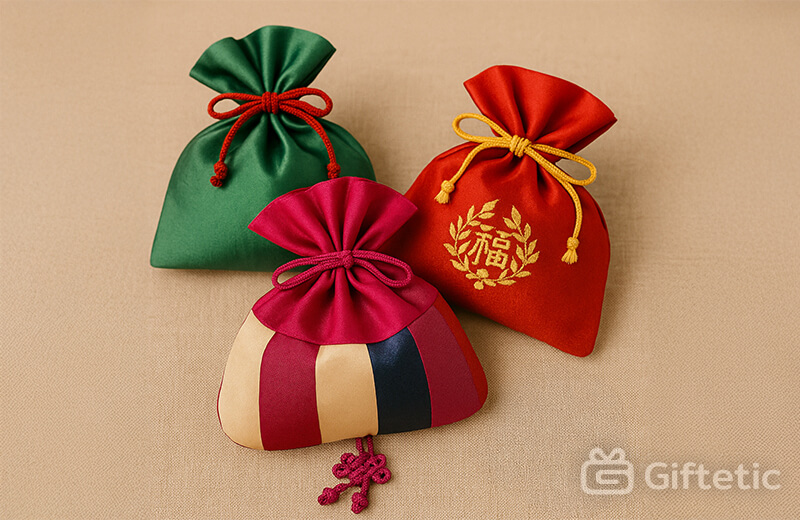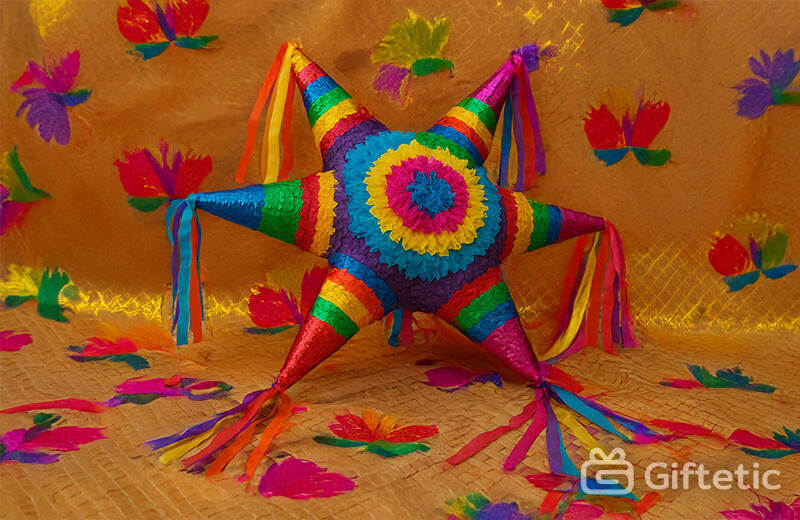Popular Holidays When People Give Gifts — Ideas, Tips, and Traditions
Gift-giving is one of humanity's most enduring traditions, weaving through cultures, centuries, and celebrations around the world. From the ancient exchange of polished shells to today's carefully curated wishlists, the act of giving has evolved into a beautiful tapestry of customs that connect us across borders and beliefs. Whether you're navigating the familiar territory of Christmas morning, discovering the rich traditions of Diwali celebrations, or understanding why Russians decorate Christmas trees for New Year's instead, the stories behind our gift-giving holidays can transform how we approach these meaningful moments of connection.
Quick Summary (TL;DR)
- Gift-giving evolved from ancient survival exchanges to modern expressions of love and respect
- Many cultures have shifted traditional Christmas elements to other holidays (like Russia's Novy God)
- Regional ceremonies like Potlatch and Aboriginal Dreamtime gifting demonstrate deep spiritual connections
- Cultural taboos are crucial — white flowers mean death in Asia, even numbers in China (except 4)
- Hidden traditions exist everywhere: Korean bokjumeuni bags, German Schultüte cones, Mexican piñata gifts
- Modern tools help navigate complex multi-cultural gift calendars and avoid cultural missteps
Major Gift-Giving Holidays Around the World
Here’s a snapshot of the key holidays when gifts are traditionally exchanged:
| Holiday | Country/Region | Date |
|---|---|---|
| Christmas | Worldwide (mainly Western countries) | December 25 (Gregorian calendar) |
| Lunar New Year | China, Vietnam, Korea, others in East/Southeast Asia | Varies — late Jan to mid-Feb (Lunar calendar) |
| Diwali | India, Nepal, Sri Lanka, others | Varies — Oct/Nov (Hindu lunar calendar) |
| Eid al-Fitr | Muslim-majority countries worldwide | Varies — 1st of Shawwal (Hijri calendar) |
| Hanukkah | Jewish communities worldwide | Varies — Nov/Dec (Hebrew calendar) |
| Valentine’s Day | Worldwide | February 14 (Gregorian calendar) |
| White Day | Japan, South Korea, Taiwan | March 14 (Gregorian calendar) |
| Obon | Japan | August 13–15 (Gregorian calendar) |
| Nowruz | Iran, Central Asia, Kurdish regions | March 20–21 (Persian calendar) |
| Children’s Day | Many countries (e.g. Japan, Mexico, Korea) | Varies (e.g. May 5 in Japan) |
| Germany’s Schultüte | Germany | First day of school (varies by state) |
The Ancient Roots of Gift-Giving
Long before shopping malls and online wishlists, our ancestors understood something profound about human nature: giving creates bonds that survive hardship. Archaeological evidence shows that hunter-gatherer societies exchanged polished teeth, colorful beads, and rare stones not just for survival, but as expressions of alliance and respect. The Natufian culture of the Levant, dating back 15,000 years, buried their dead with carefully crafted jewelry — early evidence that gifts transcended the boundary between life and death.
"The gift is never neutral. It creates relationships that bind people together across time and space."
These early exchanges laid the groundwork for what anthropologist Bronisław Malinowski would later document as the Kula Ring — a ceremonial trading system in Papua New Guinea where shell necklaces and bracelets traveled between islands, creating networks of trust and mutual obligation that lasted generations. The gifts themselves weren't the point; the relationships they fostered were everything.
But gift-giving's origins go deeper than social bonding. In many indigenous cultures, gifts were believed to carry the giver's essence, creating spiritual connections that outlasted physical presence. Aboriginal Australian cultures speak of "increase ceremonies" where gifts to the land ensure the continuation of animal species and seasonal cycles — a practice that views giving as fundamental to cosmic balance.
The Great Holiday Transformations
Russia's Christmas That Became New Year
Perhaps no example better illustrates cultural adaptation than Russia's Novy God (New Year), where familiar Christmas elements — decorated evergreen trees, gift-giving, and a jolly gift-bringer — were transferred to January 1st celebrations. Under Soviet rule, religious Christmas was discouraged, but the beloved traditions found new life in secular New Year festivities.
Ded Moroz (Grandfather Frost) replaced Santa Claus, assisted by his granddaughter Snegurochka (Snow Maiden) rather than elves. The transformation was so complete that many Russians today associate Christmas trees more strongly with New Year than with the Orthodox Christmas celebrated on January 7th. This cultural shift demonstrates how deeply embedded gift-giving traditions can migrate between holidays while maintaining their emotional resonance.
"Novy God became more than a holiday replacement — it became a uniquely Russian celebration that preserved the magic of gift-giving while creating new family traditions."
The Three Kings' Revolution
Similarly, many Latin American countries have elevated Día de los Reyes (Three Kings' Day) above Christmas itself. In Mexico, Argentina, and Spain, January 6th becomes the primary gift-giving occasion, with children leaving shoes out to be filled with presents — creating a magical second Christmas that extends the holiday season well into the new year.
Ethiopia's Unique Calendar
Ethiopia celebrates Christmas (called Genna) on January 7th due to the Julian calendar, but their New Year (Enkutatash) falls on September 11th, accompanied by the exchange of small gifts and flowers. This creates a gift-giving calendar completely out of sync with the Western world, reminding us that time itself is culturally constructed.
Global Festival Traditions That Warm the Heart
The Winter Celebration Constellation
December and January bring a constellation of gift-giving holidays that illuminate the darkest time of year, each with distinct cultural fingerprints. Christmas, perhaps the most globally recognized, has evolved from St. Nicholas's anonymous gift-dropping to today's elaborate wishlist traditions where families share their hopes and dreams through carefully curated lists.
Hanukkah's eight nights of gifts celebrate the miracle of light lasting against impossible odds, with each gift traditionally growing in significance through the festival. Kwanzaa's seven principles encourage gifts that honor African heritage and community values — often handmade items or books that educate about Black history and culture.
Festivals of Light and Abundance
Diwali transforms homes into sparkling wonderlands while families exchange sweets, gold jewelry, and new clothes. But the tradition goes deeper than material gifts — families often give to employees, servants, and community members, embodying the festival's principle that prosperity should be shared. The exchange of mithai (sweets) isn't just about taste; different sweets carry specific meanings, with laddu representing joy and barfi symbolizing celebration.
"During Diwali, we don't just light diyas in our homes — we light up relationships through the deliberate joy of giving. Each sweet shared carries a prayer for the recipient's prosperity."
Eid celebrations bring their own nuanced traditions. Eid al-Fitr marks the end of Ramadan with gifts of new clothes (especially for children), money called Eidi, and special foods shared with neighbors regardless of their faith. Eid al-Adha emphasizes charitable giving, with families often organizing their gift-giving around the Islamic principle of caring for those less fortunate.
The Lunar New Year's Complex Protocols
Chinese New Year gift-giving follows intricate rules that reflect deep cultural beliefs. Red envelopes (hongbao) must contain even amounts of money — except for amounts containing the number 4, which sounds like "death" in Chinese. The bills must be new and crisp, symbolizing fresh starts and respect for the recipient. Children receive gifts, but so do unmarried adults, creating an interesting social dynamic around relationship status.
But it's not just about money. Food gifts carry elaborate symbolism: oranges for good luck, dried dates for early prosperity, and candied fruits for sweet relationships. Even the timing matters — gifts given too early can be seen as rushing luck, while gifts given too late might miss the fortune window.
Love's Seasonal Celebrations
Valentine's Day has sparked unique regional adaptations worldwide. In Japan, women traditionally give chocolate to men, but there's a hierarchy: giri-choco (obligation chocolate) for colleagues and male friends, and honmei-choco (true feeling chocolate) for romantic interests. South Korea takes this further with monthly romantic holidays throughout the year, including White Day (March 14) when men reciprocate, and Black Day (April 14) when single people eat black noodles together.
Wales celebrates Dydd Santes Dwynwen (Welsh Valentine's Day) on January 25th, with the traditional gift of intricately carved wooden love spoons. Each symbol carved into the spoon carries meaning: wheels for hard work, beads for the number of children desired, chains for togetherness.
Ceremonial Exchanges That Build Communities
Some of the world's most fascinating gift-giving traditions happen outside the calendar of major holidays, embedded in the social fabric of indigenous communities and regional cultures where gifts serve as invisible threads weaving society together.
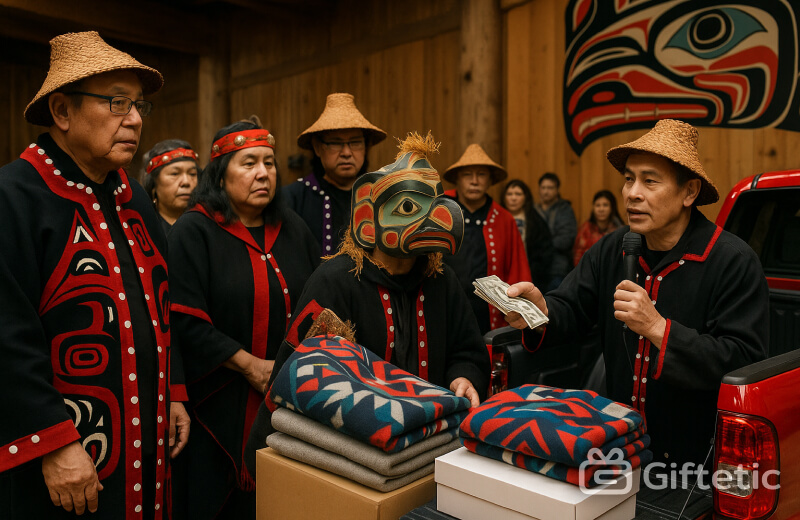
The Potlatch: Abundance Through Giving
Pacific Northwest First Nations communities practice Potlatch — elaborate feasts where hosts give away vast quantities of goods to demonstrate their wealth and generosity. But here's the beautiful paradox: the more you give away, the higher your social status becomes. Potlatch ceremonies can last for days, with gifts ranging from traditional items like blankets and carved masks to modern goods like trucks and cash.
The practice was so threatening to European colonial concepts of wealth accumulation that it was banned by both Canadian and US governments for decades. The lifting of these bans in the 1950s marked not just legal victory but cultural restoration of indigenous values that prioritize community wealth over individual accumulation.
Aboriginal Australian Increase Ceremonies
Aboriginal Australian cultures practice "increase ceremonies" where community members give gifts to sacred sites to ensure the continuation of animal species and seasonal cycles. These aren't mere rituals — they represent a worldview where humans are caretakers responsible for maintaining cosmic balance through thoughtful giving to the land itself.
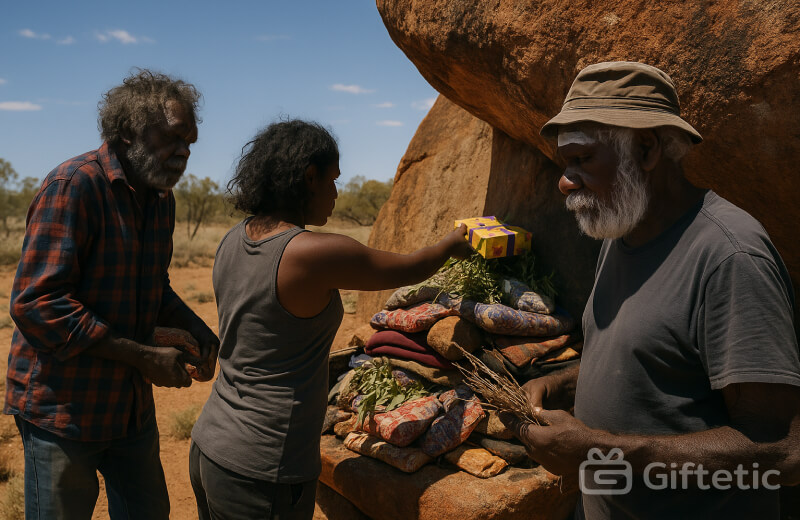
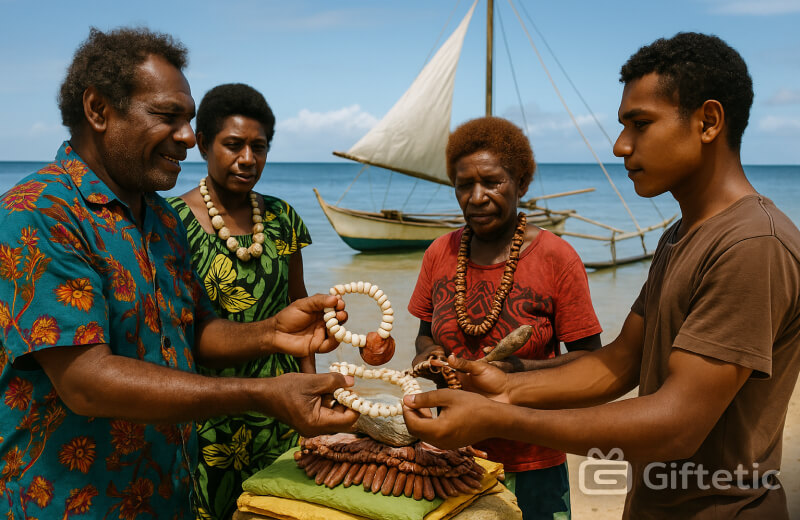
The Kula Ring: Gifts That Travel Oceans
In Papua New Guinea's Trobriand Islands, the Kula Ring continues to fascinate anthropologists a century after Malinowski first documented it. Ceremonial shell necklaces (soulava) travel clockwise between islands while shell bracelets (mwali) move counterclockwise, creating an endless circulation of gifts that maintains peaceful relationships across vast ocean distances.
Each piece of Kula jewelry carries the history of everyone who has possessed it, creating narratives that span generations. The goal isn't to accumulate these treasures but to become a respected link in an ancient chain of reciprocity.
Lakota Give-Away Ceremony
The Lakota tradition of Give-Away ceremonies demonstrates profound spiritual wisdom: by giving away your possessions, you show humility and create space for new blessings to enter your life. These ceremonies often accompany major life events — births, graduations, spiritual milestones — turning personal achievements into community celebrations where success is measured by how much you can give away, not accumulate.
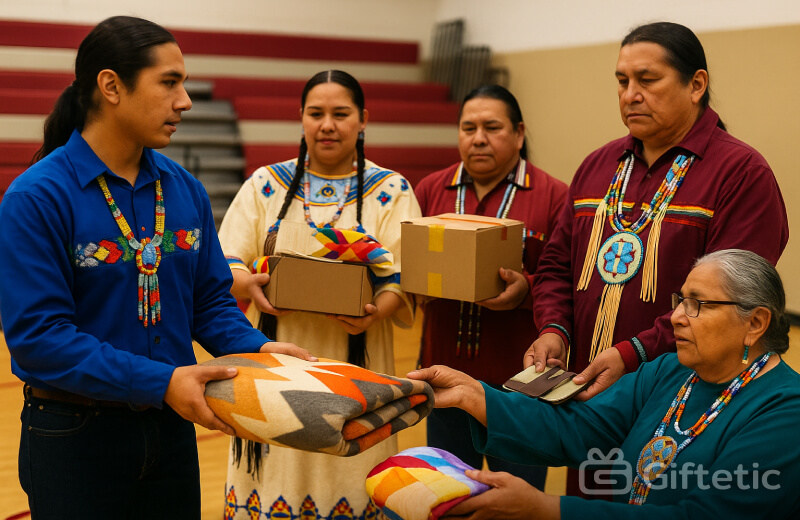
The Dangerous Art of Cultural Gift-Giving
Understanding cultural nuances can mean the difference between strengthening relationships and causing deep offense. Each culture has developed intricate protocols around what to give, how to give it, and what never to give under any circumstances.
The Flower Minefield
Colors carry profound symbolism that varies dramatically by culture. White flowers represent death and mourning throughout most of Asia, making a beautiful white bouquet a funeral gift. In Russia, yellow flowers suggest infidelity and broken relationships. Mexican cultures associate marigolds with Day of the Dead celebrations, making them inappropriate for happy occasions.
Even the number of flowers matters. In many European cultures, odd numbers are for celebrations while even numbers are for mourning. But in China, pairs are lucky — except when they're not. The complexity requires careful research or local guidance.
The Clock Catastrophe
In Chinese culture, giving a clock is one of the gravest gift-giving errors possible. The phrase "giving a clock" (送鐘, sòng zhōng) sounds identical to "attending a funeral" (送終, sòng zhōng), making it essentially a death wish. Similarly, anything in sets of four should be avoided, as the number four (四, sì) sounds like death (死, sǐ).
Islamic Considerations
Islamic gift-giving traditions emphasize purity and appropriateness. Alcohol is obviously forbidden, but subtler restrictions include leather goods from non-halal animals, gold jewelry for men, and silk clothing for men. Understanding these guidelines shows respect for the recipient's faith and values.
Japanese Gift Presentation Rituals
In Japan, how you present a gift is just as important as the gift itself. The wrapping becomes part of the gift, often more expensive than the contents. Recipients typically don't open gifts in the giver's presence, allowing them to appreciate the presentation privately and avoid any awkward reactions.
The omiyage culture elevates souvenir-giving to an art form. When traveling, it's customary to bring back local specialties for colleagues, friends, and family. But recipients often politely refuse the gift multiple times before accepting — a ritual dance that shows mutual respect and humility.
"In Japan, the wrapping tells a story before the gift is even opened. We have a saying: 'The heart of the giver is reflected in the presentation.'"
Regional Specialties and Secret Traditions
Scandinavian Subtleties
Swedish families practice "Klappar under granen" (gifts under the spruce), but with a twist — gifts are often accompanied by small poems or riddles that must be solved before opening. Danish traditions include "Pakkeleg" — a dice game where participants steal wrapped gifts from each other, turning gift-giving into an evening's entertainment.
Middle Eastern Hospitality
Arab cultures practice "karam" (generosity) as a core value, where refusing hospitality or gifts can be deeply insulting. However, the initial offer is often politely declined as a show of respect, leading to a gentle insistence from the giver. This dance of offering and declining can happen several times before the gift is appropriately accepted.
Indian Subcontinent Intricacies
Indian gift-giving varies dramatically by region and community. In Bengali culture, new clothes are essential for Durga Puja celebrations. Sikh traditions emphasize giving without expectation of return, embodied in the concept of "seva" (selfless service). South Indian families often exchange coconuts and betel leaves for good luck during festivals.
African Ubuntu Philosophy
Southern African cultures embrace "Ubuntu" — the belief that "I am because we are." Gift-giving reflects this interconnectedness, with successful community members expected to share their prosperity through gifts, school sponsorships, and community support. The gifts often prioritize practical needs: school fees, medical expenses, or business startup capital.
Modern Adaptations and Digital Transformations
Today's interconnected world has created beautiful hybrid traditions that blend ancient wisdom with contemporary convenience, while also preserving the emotional core of traditional practices.
Digital Red Envelopes
Chinese New Year hongbao have seamlessly transitioned to digital platforms like WeChat and Alipay, where family members can send virtual red envelopes with the same ceremonial significance as physical ones. The digital versions often include animations, personalized messages, and even location-based features that maintain the surprise element.
Virtual Eidi and Global Families
The Islamic tradition of giving Eidi (monetary gifts during Eid) has adapted to digital banking, with families sending money transfers to relatives across the globe. Diaspora communities use apps to coordinate group gifts, ensuring that traditional obligations are met despite physical separation.
Pandemic-Era Innovations
COVID-19 accelerated creative gift-giving solutions: virtual unwrapping ceremonies over video calls, doorstep delivery surprises, and collaborative online wishlists that allow extended families to coordinate gifts safely. These innovations often proved so convenient that they've persisted post-pandemic.
Corporate Cultural Integration
Modern workplaces increasingly recognize diverse gift-giving traditions, creating inclusive holiday policies that honor everyone from Christmas celebrants to Diwali observers. Personal connections management becomes essential when navigating colleagues' varied cultural backgrounds and preferences, helping maintain respectful workplace relationships across cultural lines.
The Psychology Behind Cultural Gift Rules
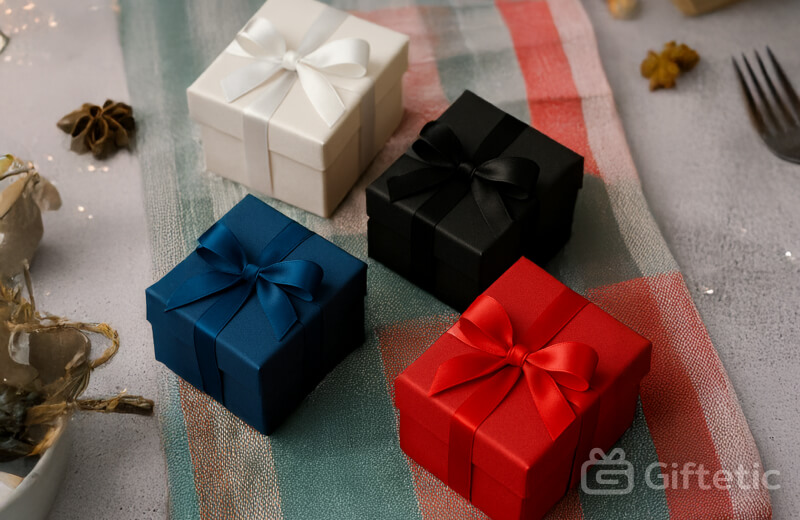
Why Colors Matter So Much
Color symbolism in gift-giving often stems from deep historical and religious associations. Throughout Asia, white, black, and blue are associated with mourning and should be avoided in gift wrapping, while red symbolizes luck and prosperity. These aren't arbitrary rules — they reflect centuries of cultural meaning-making around life, death, and fortune.
Numbers and Superstition
Numerical significance in gifts reveals mathematical relationships with language and belief systems. Chinese culture's avoidance of the number four demonstrates how phonetic similarity can create powerful taboos, while the preference for even numbers in many cultures reflects beliefs about balance and completion.

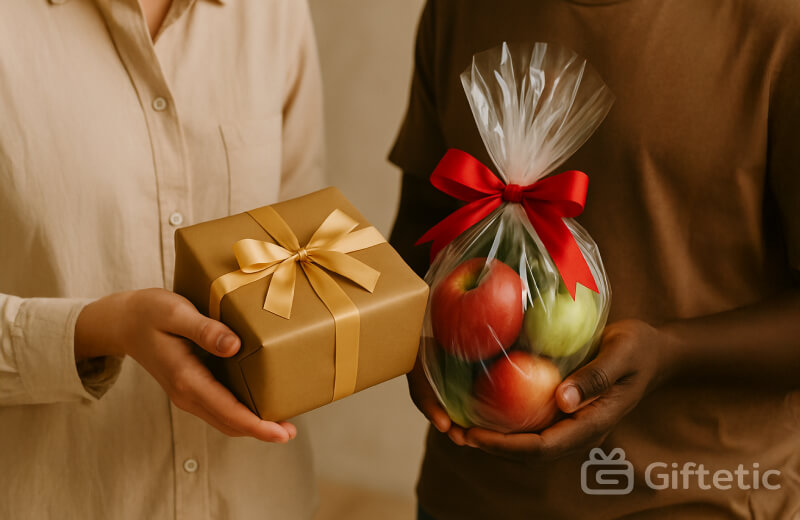
Reciprocity and Social Debt
Many cultures view gifts as creating social obligations that must be carefully managed. Japanese gift-giving includes an expectation of return gifts of roughly equal value, while some African cultures emphasize that gifts should flow toward those with greater need, creating upward social mobility rather than horizontal exchange.
Creating Inclusive Celebrations
As communities become increasingly diverse, creating gift-giving traditions that honor multiple cultures simultaneously requires creativity and careful planning.
The Fusion Approach
Some families create entirely new traditions that blend their various cultural backgrounds. A Chinese-Jewish family might exchange gifts during both Hanukkah and Chinese New Year, creating red-and-blue wrapped presents that honor both traditions. Mexican-American families might fill piñatas with Three Kings' Day gifts on January 6th.
Educational Gift-Giving
Consider gifts that introduce recipients to your cultural traditions: books about your heritage, traditional foods they've never tried, or crafts that represent your background. This transforms gift-giving from simple exchange into cultural bridge-building.
Community Celebration Coordination
Organizations and neighborhoods increasingly coordinate celebrations that honor multiple traditions. A community center might host a "Festival of Lights" celebration that includes Diwali, Hanukkah, and Christmas elements, with gift exchanges that respect all traditions involved.
The Future of Cross-Cultural Gift-Giving
As our world becomes increasingly connected, gift-giving traditions continue to evolve and blend, creating new hybrid customs while maintaining their emotional and spiritual significance.
Technology as Cultural Bridge
Platforms like Giftetic make it easier to organize and track gifts across multiple cultural celebrations, ensuring no important relationship goes unrecognized while respecting diverse traditions. Visibility management features allow people to share culturally appropriate gift ideas while maintaining privacy about sensitive aspects of their celebrations.
Globalization's Double Edge
While globalization risks homogenizing gift-giving traditions, it also creates opportunities for cultural exchange and hybrid celebrations that honor multiple backgrounds simultaneously. Young people increasingly create new traditions that blend their heritage with global influences, ensuring traditions evolve rather than disappear.
The beauty lies not in perfecting every cultural protocol, but in approaching each tradition with genuine curiosity and respect. Whether you're participating in a Potlatch ceremony, sending digital hongbao, or navigating the delicate art of omiyage selection, the heart of gift-giving remains universal: creating connections that transcend material possessions.
"In every culture I've studied, gift-giving serves the same fundamental purpose — it says 'I see you, I value you, and I want to strengthen our bond.' The methods may vary, but the message is universal."
As you navigate your own gift-giving journey across cultures and celebrations, remember that the most meaningful gifts aren't always the most expensive — they're the ones that show you've paid attention to what matters to the person receiving them. Whether it's honoring their cultural background, supporting their dreams, or simply demonstrating that you understand their values, thoughtful gift-giving remains one of humanity's most beautiful and complex traditions.

